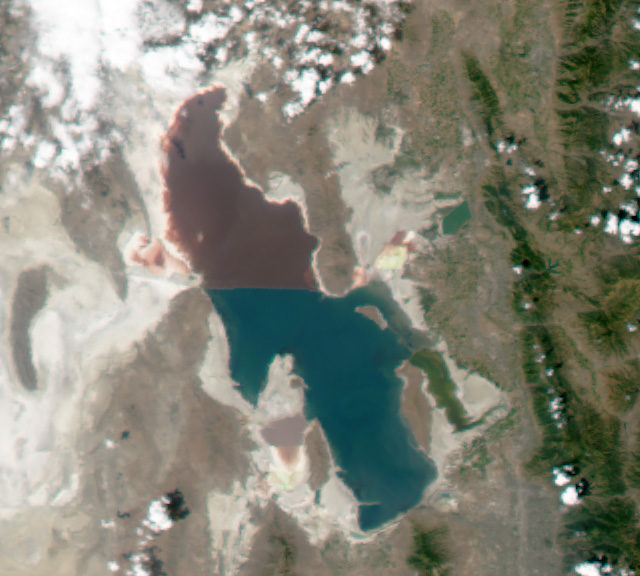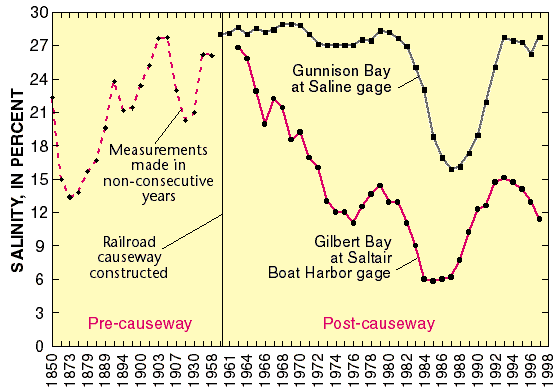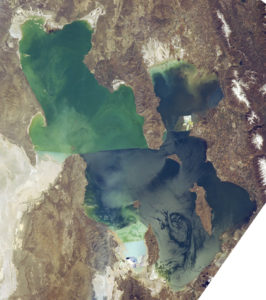
The Lovely Rosy Waters of the Great Salt Lake
THE GREAT SALT LAKE
The Great Salt Lake is so salty that no fish can live in it. Regardless, it supports its own unique fishery based on Artemia salina, the brine shrimp. Only organisms adapted to extreme salinity can survive. The microscopic ones give the northern half of the lake its rosy color. The conditions that support these rosy-color organisms are:
- an accident of geography ( interior drainage).
- a railroad causeway
An accident of geography
The Great Salt Lake is a terminal lake. This means its waters are trapped and never reach the ocean. Water can only leave through evaporation.
The lake is fed by three rivers and several streams. Most of these flow into the lake’s southern half. They carry dissolved solids which are then dumped into the lake. Water and dissolved solids flow into the lake but only the water can leave through evaporation. As a result, the dissolved solids become ever more concentrated because unlike the water, they can’t escape. The most abundant of these dissolved solids is NaCl, common table salt.
Dividing the Great Salt Lake in Two

In 1959, Union Pacific built a causeway across the Great Salt Lake thus dividing the lake in two. This causeway inhibits the mixing of water between the two halves of the lake. Since around 95% of the available stream water goes into the southern half, this means that the northern arm of the lake is now more salty while the southern arm is less salty. In the northern arm, the average salt concentration is an 317 grams/liter. The southern half has an average concentration of 142 grams/liter. In terms of percent, 317 grams/liter is the same as 24% by weight, and 142 grams/liter is 12% by weight. In contrast, ocean water has an average salinity of 3.5% by weight.
USGS figure showing salinity in the north and south halves of the Great Salt Lake before and after the causeway; from https://ut.water.usgs.gov/greatsaltlake/salinity/images/saltplot2.gif
CREATURES OF SALT
Other than salt-adapted invertebrates, the only things that live in the Great Salt Lake are salt-tolerant microbes and algae. Because of the extreme salinity, only a handful of these organisms can survive in the northern half of the lake. The most exotic of these are salt-tolerant viruses known as haloviruses. The identification of haloviruses is currently an active area of research and only a handful of studies have been published to date on their existence.
Haloarchaea
Haloarchaea are archaea which need extreme saline conditions to thrive. In the Great Salt Lake, these archaea include the genera of Halobacterium, Halococcus and Haloquadratum. They share the same protein, bacteriorhodopsin, which is a purplish-red. The rosy tint in the northern arm of the lake is partly due to the bacteriorhodopsin of these Haloarchaea.

Recent research has made a tentative identification of the newly-recognized and rare halophilic bacteria Salinibacter ruber in the northern arm of the lake. The identification was based on DNA sequencing. As of the date of this post, this pink-colored microbe has not yet been cultured from out of the lake.
Algae

Dunaliella salina is the other organism behind the pink color in the northern arm of the lake. In fact, it may be the primary cause of the pigmentation. This algae is another salt lover. Its reddish coloration comes from β-carotene. In fact, Dunaliella salina is so rich in β-carotene that some people farm it or vat-grow it commercially for its carotene content.
Dunaliella veridis is the salt-loving algae common in the Great Salt Lake. It is found exclusive to the southern half of the lake but it is not at all rosy or pink. It’s green.

These two salt-loving algae control on the color of the lake water. In 1985, a year when there were floods throughout the western USA, an unusually large amount of freshwater flowed into the northern arm of the lake. The salinity dropped to ~15%: these were good conditions for Dunaliella veridis but deadly for Dunaliella salina. The Dunaliella salina died off in the northern arm and Dunaliella veridis moved in. The NASA satellite image above shows what happened to the lake color when Dunaliella salina died off. The northern arm of the lake lost its rosy tint and turned green instead.
Sources
- Swati Almeida-Dalmet, Masoumeh Sikaroodi, Patrick M. Gillevet, Carol D. Litchfield, and Bonnie K. Baxter, “Temporal Study of the Microbial Diversity of the North Arm of the Great Salt Lake, Utah, U.S.,” Microorganisms. 2015 Sep; 3(3): 310–326. Published online 2015 Jul 2. doi: 10.3390/microorganisms3030310. Free copy available on Pub Med: https://www.ncbi.nlm.nih.gov/pmc/articles/PMC5023243/ (acessed July 2017).
- Mike Dyall-Smith, “Research Interests,” http://www.haloarchaea.com/research/index.html (Accessed July 23, 2017).
- Genetic Science Learning Center, “Free-Floating Microbes,” University of Utah; http://learn.genetics.utah.edu/content/gsl/foodweb/ffmicrobes/ (accessed July 23, 2017).
- David Goodsell, “Molecule of the Month: Bacteriorhodopsin,” Research Collaboratory for Structural Bioinformatics Protein Data Bank, March 2002, doi:10.2210/rcsb_pdb/mom_2002_3; https://pdb101.rcsb.org/motm/27 (accessed July 23, 2017).
- NASA, “Algae in the Great Salt Lake,” July 16, 2007; https://earthobservatory.nasa.gov/IOTD/view.php?id=7857&eocn=image&eoci=related_image (accessed July 23, 2017).
- NASA, “Drought Dwindles the Great Salt Lake,” August 1, 2003; https://earthobservatory.nasa.gov/IOTD/view.php?id=3672&eocn=image&eoci=related_image (accessed July 23, 2017).
- A. Oren, “The ecology of Dunaliella in high-salt enviroments,” J Biol Res (Thessalon). 2014 Dec; 21(1): 23. Published online 2014 Dec 18. doi: 10.1186/s40709-014-0023-y. Free copy available on Pub Med: https://www.ncbi.nlm.nih.gov/pmc/articles/PMC4389652/ (accessed July 23, 2017).
- Wynne Parry, “Tiny Organisms Turn Great Salt Lake Pink,” LveScience.com, January 29, 2013; https://www.livescience.com/26675-salt-loving-microbes-lake.html (accessed July 23, 2017).
- F. J. Post, “The microbial ecology of the Great Salt Lake,” Microb Ecol. 1977 Jun;3(2):143-65. doi: 10.1007/BF02010403. Abstract: Pub Med, https://www.ncbi.nlm.nih.gov/pubmed/24233467 (accessed July 23, 2017).
- Doyle Stephens and Joe Gardner, “The Great Salt Lake,” WRI99-4189, 2007, USGS; https://pubs.usgs.gov/wri/wri994189/PDF/WRI99-4189.pdf (accessed July 24, 2017)
- USGS, “Great Salt LAke – Planktonic and Benthic Habitats,” January 10, 2013; https://ut.water.usgs.gov/greatsaltlake/plankton/ (accessed July 23, 2017).
- Bart C. Weimer, Giovanni Rompato, Jacob Parnell, Reed Gann, B. Ganesan, Cristian Navas, Martin Gonzalez, Mario Clavel, and Steven Albee-Scott, “Microbial biodiversity of Great Salt Lake, Utah,” Natural Resources and Environmental Issues: (2009) Vol. 15, Article 3. Available at: http://digitalcommons.usu.edu/nrei/vol15/iss1/3 (accessed July 23, 2017).
- J.S. White, S.E. Null and D.G. Tarboton, “How Do Changes to the Railroad Causeway in Utah’s Great Salt Lake Affect Water and Salt Flow,” PLoS One. 2015 Dec 7;10(12):e0144111. doi: 10.1371/journal.pone.0144111. eCollection 2015. Abstract: Pub Med, https://www.ncbi.nlm.nih.gov/pubmed/26641101 (aacessed July 23, 2017).
The header image for this blog is an overhead view of one mile of the railroad causeway through the middle of the Great Salt Lake. The top of the image is to the south so the north arm of the lake is at the bottom of the image. The white swirls in the pinkish water along the causeway are salt. These salt swirls form in the backwash of waves that hit the rip rap of the causeway.
